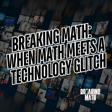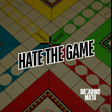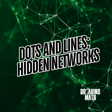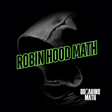Become a Creator today!Start creating today - Share your story with the world!
Start for free
00:00:00
00:00:01

Minisode 0.1: Hypercubes and Other Stranger Things
We are proud to announce that we have recorded our very first minisode! In addition, we are introducing a new blog which can be found at www.breakingmathpodcast.com/blog.html
---
This episode is sponsored by
· Anchor: The easiest way to make a podcast. https://anchor.fm/app
Support this podcast: https://anchor.fm/breakingmathpodcast/support
---
This episode is sponsored by
· Anchor: The easiest way to make a podcast. https://anchor.fm/app
Support this podcast: https://anchor.fm/breakingmathpodcast/support
Transcript
Intro & Ads
00:00:00
Speaker
Margot beamed proudly, sipping her cherry slush drink. She just added more lines to her Cox mobile plan and saved, making her feel... exquisite. Visit a Cox store today. Prices exclude Texas device activation and other fees and charges, other terms and condition supply.
00:00:15
Speaker
Lucky Land Casino, asking people what's the weirdest place you've gotten lucky. Lucky? In line at the deli, I guess? Aha, in my dentist's office. More than once, actually. Do I have to say? Yes, you do. In the car, before my kid's PTA meeting. Really? Yes. Excuse me, what's the weirdest place you've gotten lucky? I never win and tell. Well, there you have it. You can get lucky anywhere, playing at luckylandslots.com. Play for free right now. Are you feeling lucky? No purchase necessary. Voided by law. 18-plus. Terms and conditions apply. See website for details.
00:00:45
Speaker
This episode is distributed under a Creative Commons attribution share-like 4.0 international license. For more information, visit creativecommons.org.
Website Update
00:00:55
Speaker
Somebody stole our website! Oh no, whatever shall we do? I mean, I guess you could go to the new website, http://breakingmathpodcast.app, with no www for all you old timers.
00:01:13
Speaker
So breakingmapodcast.app, I mean, if you're into that sort of thing.
Podcast Creation Tips
00:01:20
Speaker
Hey, Breaking Math fans. First, I want to thank you for listening. I have an important message for everyone. You can start your own podcast right now with Anchor. Anchor lets you create and distribute your own podcast. Just get an idea, record, and upload. It's just that easy. Anyone can do it. I'm on my way to accomplishing my dream, and you can too. Just get on your device's app store and download Anchor. It contains everything you need to make a podcast. With Anchor, you can put your podcast on all the big platforms.
00:01:49
Speaker
Apple Podcast, Spotify, Google Podcast, Amazon, and more. Reach the whole world with Anchor. Best of all, Anchor is free. You have nothing to lose with a free platform. Download the Anchor app or go to anchor.fm to get started.
Behind the Scenes
00:02:08
Speaker
Here at Breaking Math, we're in the studio all the time. All the time.
00:02:13
Speaker
But when we're not, we sometimes have off-air discussions that are really on air. We do these when we're planning an episode, hanging out, or really, whenever. We'll be back in studio to talk to Owen and Mark, but first, let's take a listen.
Hypercube Applet Discussion
00:02:25
Speaker
The following clips are not studio quality recordings, they are on-site discussions.
00:02:44
Speaker
Okay, well, we're not breaking English, or rather, would we be breaking English, because then we'd be slaughtering the language. I don't know. Moving on. So this whole podcast was inspired by a new applet that Jonathan created. It's a hypercube, it's a hypercube interactive applet. And if our listeners, if you guys want to check it out, it's beautiful. It's a visual component. We just go to breakingmath.com. Breakingmathpodcast.com.
00:03:10
Speaker
Thank you. Thank you. Yeah, you can just go to breakingmathpodcast.com. I'm going to go there right now because as we're recording this, I'm here at my computer, and you can find at the very, very top, there's a new link that says hypercube. You can click on it and you've got this gorgeous picture. This thing is psychedelic. When I first saw this, you know what the first thing I thought of? A lava lamp. Actually, a lava lamp. Can you guys imagine if you had a combination of a fractal and a lava lamp? That's kind of like what you'd be seeing here, right? Yeah.
00:03:39
Speaker
haven't really studied the trails, which you have to come access by pressing space bar, but I do think they have a fractal quality.
Flatland & Dimensions Discussion
00:03:45
Speaker
Yeah, yeah, something like that. So, Jonathan, I gotta say, so I'm obviously, in addition to being the host, or one of the hosts, I'm also a listener. I think you spoil us listeners, because this is just, this is honestly one of the coolest things I've seen ever. See, when Jonathan made it, if you don't mind me, I'll describe a few details. Sure. Black background, but you've got these neon, tell us about the color palettes here.
00:04:06
Speaker
Well, it ranges from blue to red to blue again. It shifts in time. Full spectrum, right? Yeah, full spectrum. Green, pink. It's like neon colors. And you can select any number of dimensions, although if you go to more than seven or eight, you'll probably crash your computer.
00:04:23
Speaker
Yeah, so check this out guys, for our listeners, right now if you go to, I sound like an infomercial, right now if you go to breakingmathpodcast.com and just play with this applet, it's just yours to check out because it's awesome. You can control this hypercube and you start off with just two dimensions and it's a square with four different colors. You press up on the arrow key, you can see it in three dimensions.
00:04:47
Speaker
Now, one thing I wanted to bring up about the three dimensions is that when you're looking at the picture of a cube, you're not looking at a cube. You're looking at a picture of a cube, which is two-dimensional. Because some people might be asking, how can we show something that's four-dimensional and two-dimensional? The same way we show something three-dimensional and two-dimensional.
00:05:04
Speaker
Yes. You know what? You mentioned something else as well, actually. Forgive me, I have a few ideas that I wanted to mention. As you're saying this, I look forward to hearing our reader feedback. I'm going to make a blog about this, and I'm going to post our blog onto the Facebook. And eventually, one of these days, we're going to make a YouTube site. And I think we may even put this on YouTube. We want to read comments on the YouTube, because this is really interesting stuff. And I think it's great that we can share this.
Language & Communication in Ender's Game
00:05:31
Speaker
Yeah, we do have a video of it up on YouTube.
00:05:33
Speaker
But now we're going to talk a little bit about Flatland before we talk about four dimensions. We gotta talk about two. That's a book. Flatland was a book one to come out of the late 1800s. Okay now tell me is that's not a very hard book I know a lot of papers we talk about are with a lot of papers and concepts are pretty high concepts You know now the full title is Flatland Romance in two dimensions. Okay. Do you remember like what would you say the level? It's like if you're in eighth grade, can you read it? I'd say if you're a bright eighth grader you can read it
00:06:01
Speaker
If you're a bright age, okay, okay. So, well, that or just, yeah, just listen to this podcast, because we're going to talk about it. Go ahead. Yeah, so in the book, it's about a bunch of creatures that live on a two-dimensional plane, much in the same way that we live in a three-dimensional reality. These creatures obviously look the same way that our retinas are two-dimensional. Their retinas are one-dimensional, so they perceive the two-dimensional world around them
00:06:27
Speaker
using one dimensional representation. This was a fascinating concept for me to fathom for a bit and actually I had to draw I had to consider just like cartoons and I thought wait a minute so when we look around in our 3d
00:06:42
Speaker
You know, you don't think about this until you look at a photograph. A photograph captures, let's just pretend a photograph captures exactly what we see. It's not, it's not exact, but let's pretend it does. The information on a photograph, as you just pointed out, is two dimensional. You can't see what's behind my head. Yeah, exactly, I was just gonna say.
00:06:59
Speaker
behind this. Yes, exactly. You only see one side of everything. Therefore, all the information is in two dimensions. And as Jonathan said, let's just as you go into a flat land, if one cartoon in a two dimensional world looked at another cartoon, they would just see a single dimensional line, they'd only see that edge.
00:07:21
Speaker
But just like we feel like we see things in three dimensions, their brain would probably process it the same way. Yeah, yeah. But still, yeah, that's crazy to think about. All they'd see is that one side, and in two dimensions, that one side is just one dimension. Now, one other thing, and this is going to sound tangential, is that the inside of your body
00:07:43
Speaker
Okay, like if you cut through it, that's the only real inside of your body. Your guts, your stomach are not on the inside of your body. They're on the same surface as the outside of your body. This is in flat land or? In our land. That's why we can have the digestive system. It's like a tube that goes through us.
00:07:59
Speaker
In flatland, if you had a digestive system the same way that we do, it would divide the creature in half, and it would float apart. Got it. Okay, yeah, yeah, yeah. So in our dimension, we're able to have a tube that goes... Okay, okay. They would have to have organs like zippers. Oh, wow. Okay, yeah, that's fascinating. Yeah, so if you were to swallow food, it would tear them up in half, wouldn't it? Yeah, if they... Yeah, I mean, you have to...
00:08:27
Speaker
It would be a completely different physiology. Is this worth pointing out as well? This actually model works for me when I was much younger. I thought about let's draw a cartoon and pretend that that world that you're drawing is flat. If you as a third dimensional as a creator of that world, you are the god of that world. If you were to take your pencil and if you were to suddenly just jam it right through somewhere in the sky picture,
00:08:49
Speaker
Suddenly, as soon as it went through that plane, that two-dimensional plane, those flat landers would suddenly see something appear, you know, just in the air. It would just appear out of nowhere. We can see it from our perspective as a pencil going through the paper, but since they're stuck in 2D, it's just like something suddenly appears. You know what I'm saying? Yeah, and a four-dimensional creature stabbed our world with a three-dimensional, with a four-dimensional, what do you call it, cone?
Hypercubes & Spatial Dimensions
00:09:16
Speaker
Yeah. It would look like a spear to us.
00:09:18
Speaker
Wow, that's insane. And one of the cool things is, okay, we mentioned the hypercube app. We gotta talk about what is a hypercube. What is a cube? Yes, let's do that. And how is a cube related to a square? This is how. A zero-dimensional cube is a point. Yeah.
00:09:33
Speaker
A one-dimensional cube, you take two points and connect them together with a line. A two-dimensional cube, you take two one-dimensional cubes and connect the points together with lines. A three-dimensional cube, same thing, you take two squares and connect the points together with lines. And a four-dimensional cube, same thing, you take two cubes and connect the points together with lines.
00:09:53
Speaker
Wow, yeah, that pattern goes on and on for infinity. Now, this has so many physics concepts. Okay, so why do we care? And we're back on air.
00:10:06
Speaker
Somebody say something. Oh, okay. Sorry. Sorry. So, okay. Okay. So, so, so if, if, if I may, I've been dying to talk about this specific topic, you know, um, in, in, in planning for our episode on language, one of the things that I thought of is, um, a book series, I read a sci-fi book series, Ender's game and the Ender's game sequel. So we hear who's read those.
00:10:26
Speaker
Right here. I'm reading them. Okay. Yeah, you're reading them. I wonder among our listeners, that book came out in the 1980s and it has been heralded as some of the best sci-fi. I'm not going to say the best ever because that's very subjective, but it's a renowned book. Yeah, absolutely. It's been one of my favorites since I was a kid. Yeah. And the reason why I bring it up real brief and hopefully Zach, since you've read it and you've read the sequels as well, I wanted to talk about the themes in that book specifically about language and communication and misunderstanding.
00:10:55
Speaker
Anyway, I don't remember what Orson Scott Card specifically refers to the different levels of foreignness, I guess. But the idea is there's one level, it's somebody from another country. There's another level where it's somebody who speaks a wildly different language, but we can still kind of make ourselves understood. And then there's a couple other levels where we know that they're intelligent, we know that they're trying to communicate, but they are so alien and so foreign that there is not a chance
00:11:23
Speaker
and that we're ever going to understand what they're trying to say, and they're not going to understand what we're trying to say. And there's further levels than that, but those are the important three. I remember that. The term for the level that is the farthest away, and I think that this is to define species kind of the way we talk about viruses. We don't really recognize them. There's no humanity at all. They are enemies, and their lives are viral, pretty much. It's virals, I believe.
00:11:50
Speaker
Yeah, yeah, that's right. That's that is one of them. Yes. Yeah, or else no Owen and mark I know that's probably more of an anthropology related topic But I know anthropology and linguistics are intertwined true. Do you have anything? Do you have anything to comment about that? Well, um, and I know that certainly the I feel like frequently in fiction people over like underestimate just how different languages are in reality, it's
00:12:19
Speaker
It's just the wild, it's just amazing. Can you give us an example? So like, exclusivity. So if I say to you, John, oh yeah, we won the lottery. There's two different interpretations that you can have from that. That can be that you and I won the lottery or that I and someone else won the lottery.
00:12:45
Speaker
Our language has nothing to specifically detract from that, like specifically delineate that. However, there are tons of languages that do. Yeah, just thinking, I don't think Spanish does either. Yeah, no. It's pretty non-proto Indo-European. Where is this found?
00:13:07
Speaker
Oh God, Mark, do you remember where? I do not remember. We studied too many languages. I think Southeast Asian. Don't quote me. So getting back real quick to the buggers and all that nonsense. Yes. What kind of stuff were they doing differently?
00:13:30
Speaker
Okay, so just in brief, in the first Ender's Game book, you basically have humans and you have buggers. And the big theme here is that you once, through all of the information you had, you identified the buggers as Varels, or as the enemy, because they make no effort at all to communicate. The big theme here, and this is, I don't want to call it a minor spoiler, this book has been out since the 1980s, so if you wish to, this is a very, very minor spoiler, it's about the bigger theme.
00:14:00
Speaker
What we later find out is the whole time the buggers were trying their hardest to communicate with us in every way they knew how Yes, so the theme is misunderstanding and in the sequels to Ender's game there's four there is Ender's game There is the book called speaker for the dead There is the book called Xenocide and the book that I will not mention. I'm just kidding
00:14:22
Speaker
The fourth book is called Children of the Mind, and it is, I think, yes, critically. By comparison. Yes. The first three, and I'll even say the first three and a half, are some of the best science fiction that I've ever read. But in every book, you encounter so many species that communicate their mode of language is so different from ours that there are inevitable misunderstandings that lead to war. And then when you find out that there's just miscommunications, it changes your perspective.
00:14:49
Speaker
That reminds me of a very sad incident that happened when the Spanish conquistadors went to Peru. There was a misunderstanding at a dinner party and it ended up with the deaths of 3,000 people. Oh my goodness, what happened? What was the misunderstanding? Nobody actually knows now.
00:15:06
Speaker
Wow and then it was a minor understand misunderstanding that spiraled into a series of other misunderstandings Wow, you know it's funny There's a story that's completely not a crap as far as I know about Colonialists going to Australia and seeing a kangaroo I know the story and and as far as I know it's not true, but they asked the locals to
00:15:30
Speaker
What is it? They pointed at it and they're like, what is it? And they said, kangaroo, kangaroo, kangaroo. Comes out later that kangaroo means, I don't know what you're saying. Now, Owen and Mark, are you guys cringing at this apocrypha? Oh, no, I am not. Personally, I just wanted to hit on the notion of human experience. Yes, yes. Because that's what we all have as humans and that's
00:15:54
Speaker
what makes it possible that we can bridge the gaps of those communications. Even though we are expressing and compacting all these different experiences in different ways, there are
00:16:11
Speaker
they're the same experiences at a fundamental level. I'm talking to one person, I'm talking to many people, I am talking to a person, I'm talking about a person. And that's, there are just so many ways that we can understand our experiences. And that's where those levels of foreignness come into that. If you don't have
00:16:38
Speaker
that the same experience, that's all language is, it's a way of delineating experience.
00:16:46
Speaker
And that was Owen. And right now we're going to have another clip from our off episodes of Breaking Math. Why, why are we making an app and a whole mini soda on the idea of hyperspace? Cause for the longest time, and I just need to say for a lot of our viewers, I wonder how many of our viewers, when they first heard the idea of a four, you know, four spatial dimensions, we're not talking about time. A lot of people say, well, time is a dimension. And they say,
00:17:14
Speaker
The thing about time is that you can't really go backward and forward in it. That's true. So this isn't excluding time. When you talk about four spatial dimensions or five spatial dimensions, it's very, very hard to wrap your mind around. I think a lot of science fiction has made it popular. You guys know recently, what was the show? Stranger Things made it popular when they were talking about the idea of more dimensions. They used the same analogy that was used in that great PBS series, The Elegant Universe.
00:17:41
Speaker
I don't like this analogy, and the only reason why I say I don't like it is because it doesn't settle well with me. It doesn't explain things well. Or they say, you know, you can have a one-dimensional line, but if you can zoom in on that line, that line would be like a three-dimensional cable, and you could walk around that line. That analogy doesn't settle well with me. What do you think about that? I think that analogy is missing a few points. Yeah.
00:18:04
Speaker
One of the reasons why we care about more than three dimensions is because, like, just practically... Oh, I'm so sorry. I wanted to real quickly just address something that I don't like about so-and-stranger things. They talk about the upside down, and they say it's kind of another dimension. Kind of like, you know, if that one single line was more than one dimension, they say it's the upside down part of that line.
00:18:25
Speaker
But the problem is that in some sci-fi now, they fuse together an alternate universe, like in quantum mechanics, as well as another dimension. And those aren't the same thing. Here's why a lot of people get confused about that, actually. What would it be like walking on the surface of a hypercube? You can imagine it like this. You have cubic rooms.
00:18:49
Speaker
You are in one room, you start in this room, it's a kitchen, right? You open the door, you go into the next room, and it's the bathroom. You open the door again, because this bathroom has two doors apparently, and it's the living room. You open up another door, it's the den. And you open up the door, you keep going in a straight line, you open up that door, you're back in the kitchen. And if that seems weird to you, imagine a two-dimensional creature living on the surface of a three-dimensional cube. They would go around the cube. And every time they passed a line on the cube, they'd be going through a door.
00:19:19
Speaker
Okay. Yeah. Oh, that's a fundamental exercise. Okay. So... There's actually a whole story written about it. Yeah. Just kind of Google hypercube story
Knots in Physics
00:19:28
Speaker
and you'll find it. It was written sometime in the thirties. Nice. Nice. Oh, and by the way, I think the other thing why we care about this mathematics is this is used in a lot of out there physics like string theory. String theory has, you know, I think 11. Is it 10 special dimensions plus time? 11. Okay. Well, 10 plus time. Yeah. But another
00:19:47
Speaker
more practical reason why we care about it is because a lot of data that we pick up all the time, surveys, things like that, is in multiple dimensions. When we analyze it, we have to analyze things that are existing in multiple spatial dimensions. For example, if you correlate that data, you're looking at a four-dimensional line.
00:20:04
Speaker
Okay. Okay. Interesting. Nice. Nice. So even it has some conceptual applications as well. Okay. That's fascinating. I also like to think about the Big Bang. This is just a mental exercise. When we think about the Big Bang, what blows my mind oftentimes is we think about it coming from a singularity, which is also the center of a black hole, which is one. Now I'm still confused. Is a singularity
00:20:25
Speaker
one-dimensional or is a singularity zero dimensional? It could be infinite dimensional too. I mean a singularity is just a point. So that point, if it exists by itself, it exists in every dimension and no dimensions at the same time. That's trippy. Okay, so I'm not going to answer that question. I'll leave it up. But with a big bang, what blows my mind is why did the big bang settle on from we have essentially, I don't want to say nothing, but I don't have a better term for it, a singularity.
00:20:54
Speaker
or maybe nothing but you know what is something three two one yeah why so how long after so if at times zero like like at the beginning of the big bang before it even starts or even time you know like right before the big bang you know we don't have any any meaningful spatial dimensions how soon after the big bang do we have three spatial dimensions and time and i noticed how i said how soon because that implies a time passing
00:21:24
Speaker
Oh yeah, I mean, I have a lot of theories that go into this, but one thing that I did want to talk, and they're a little bit too out there to talk about on this podcast, but one thing that I did want to talk about is, and this might be the reason why the universe settled in three dimensions, is a concept of knots. Yeah, yeah, knots. How would a flat line dare tie a knot?
00:21:44
Speaker
Oh my gosh, it's impossible. It is impossible because the line can't go through itself. Yeah. Okay. Yeah. Yeah. Wow. Okay. Yeah. Yeah. So, so that just take a minute, marinate on that concept in a flat universe. You can't tie a meaningful knot. Now you can just go make spirals. Yeah. It would just cut into, yeah, until it, until the line cut itself.
00:22:05
Speaker
Yeah, and it's not a knot. Now in three dimensions we do knots all the time. There's actually a branch of math about it called knot theory. Now how do four-dimensional creatures make a line into a knot? Let me think about that for a minute here. So it's clearly done in three dimensions. Well, it could be done in four dimensions. Let's pretend it's a four-dimensional object. And a four-dimensional creature though
00:22:26
Speaker
could make the line pass through itself by just moving a piece of it into another dimension. And then going, there's no such thing as knots in more than three dimensions or less than three dimensions. Knots only exist in three dimensions. OK.
00:22:40
Speaker
And that might be the reason why the universe is three dimensional. Interesting. Okay. And what we're going to say, like what objects require knots to, to, to exist? Well, I mean, besides our own physiology, which I mean, that's not a valid thing to look at because the universe could have developed without us. But I'm guessing that there's a lot of interactions, especially those that are in, um,
00:23:06
Speaker
like that require Feynman diagrams, which are subatomic diagrams to model require knots to exist.
Light-hearted Conclusion
00:23:13
Speaker
Interesting, interesting. Wow, so what you're saying is, is it not, is it meaningless in four dimensions? I'm not quite... There's no way, there's no way to manipulate a line so that when you pull both ends, it ties. Okay, okay. Oh, because yeah, yeah, and 4D, that's just nothing. It's like doing a redundant thing. It's kind of like in 2D, if you draw an S, right?
00:23:32
Speaker
Yeah, and this has been proven. In three dimensions, if you take a box of string and shake it, you get knots. That's why your headphones get knotted up in your pocket. There's a mathematical reason behind that. Ah, so next time your headphones, your iPhones get all knotted up and say, oh, three dimensions. Yeah, only four dimensions. You wouldn't have a digestive system, but you would have.
00:23:52
Speaker
Perfect headphones. That's right. Okay. So this has been a Breaking Math Minisode. Minisode? Sure. And we're not reading this. No, we're not. This is totally off the cuff. Off the cuff it is. And be sure to turn in on odd Tuesdays for full episodes of Breaking Math. I'm Jonathan. And I'm Gabriel. And this has been made possible with the support of KUNM Generation Listen. Okay, round two. Name something that's not boring.
00:24:22
Speaker
Laundry? Ooh, a book club! Computer Solitaire, huh? Oh, sorry, we were looking for Chumba Casino.



















